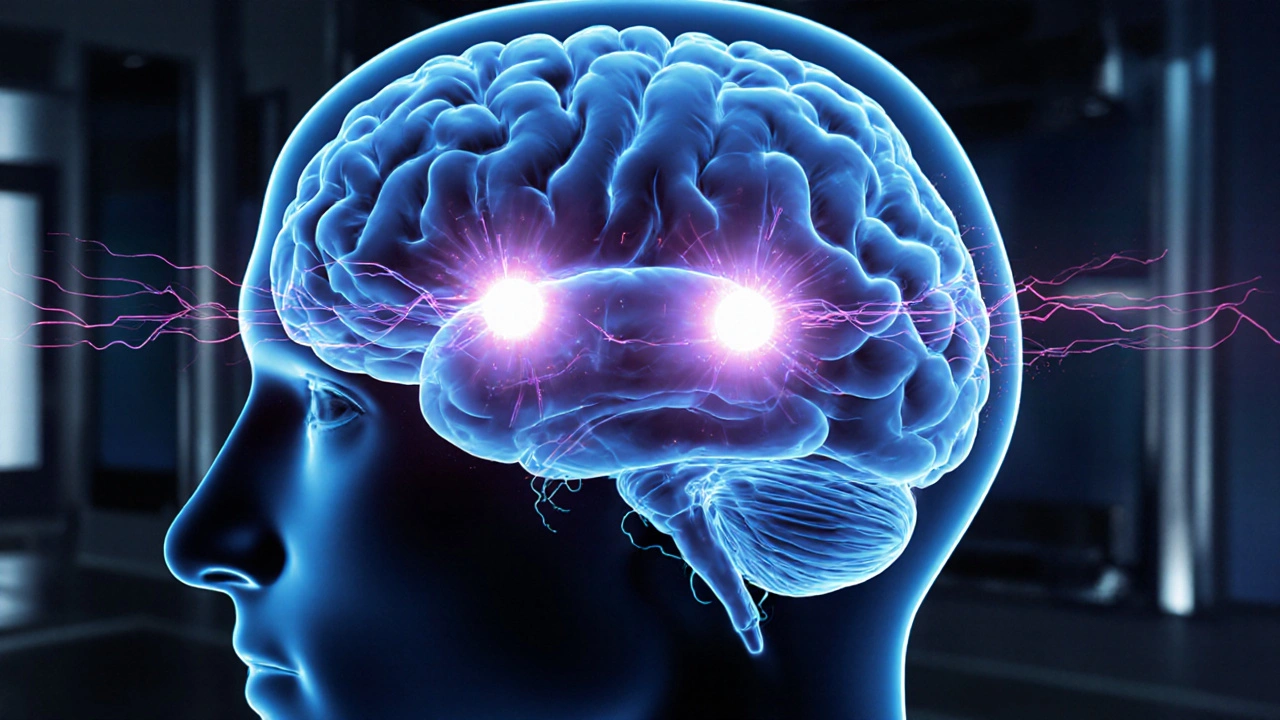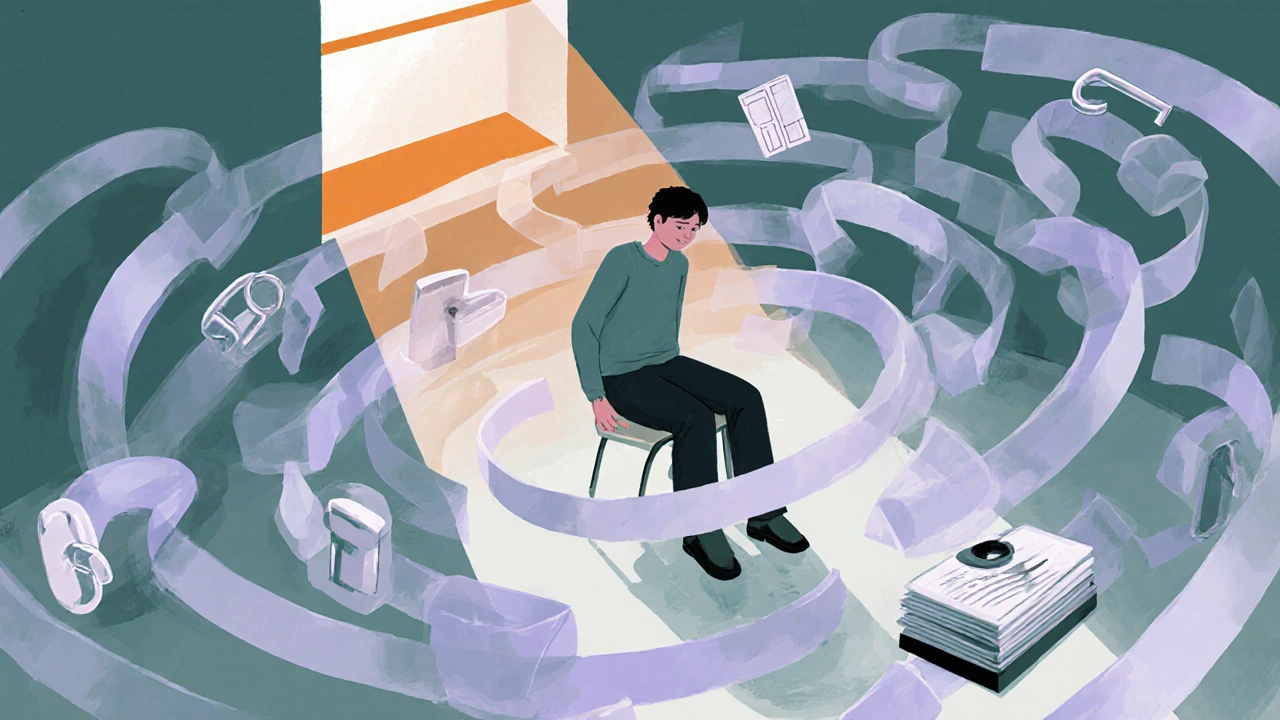OCD Treatment Plan Matcher
Recommended Treatment Plan
Living with Obsessive-Compulsive Disorder (OCD) can feel like being trapped in a loop you can’t escape. Fortunately, modern research offers a range of proven OCD treatment paths, from psychotherapy to advanced neuromodulation. Below is a practical roadmap that helps you decide which option fits your situation.
Key Takeaways
- First‑line care is Cognitive‑Behavioral Therapy with exposure and response prevention (ERP).
- Selective serotonin reuptake inhibitors (SSRIs) and clomipramine are the most supported medication choices.
- When medication and therapy don’t fully work, augmentation with low‑dose antipsychotics or neuromodulation (DBS, TMS) may help.
- Age, severity, comorbid conditions, and personal preference drive the final plan.
- Regular monitoring of side‑effects and adherence boosts long‑term success.
Understanding Obsessive‑Compulsive Disorder
Obsessive‑Compulsive Disorder affects roughly 2% of the population worldwide. It’s marked by intrusive thoughts (obsessions) and the urge to perform repetitive actions (compulsions) to neutralize anxiety. The condition often appears in late childhood or early adulthood, and can co‑occur with depression, anxiety, or tic disorders.
Diagnosing OCD follows the DSM‑5 criteria: the obsessions or compulsions take up more than an hour daily, cause marked distress, and aren’t better explained by another condition. Severity is usually measured with the Yale‑Brown Obsessive‑Compulsive Scale (Y‑BOCS), a 0‑40 point tool guiding treatment intensity.
First‑Line Psychotherapy: Cognitive‑Behavioral Therapy and ERP
Evidence from the National Institute for Health and Care Excellence (NICE) 2023 guidelines places Cognitive‑Behavioral Therapy (CBT) with an exposure and response prevention (ERP) component at the top of the treatment ladder. ERP involves deliberately confronting feared triggers while refraining from the usual compulsion.
Typical ERP protocol:
- Identify a hierarchy of obsessive triggers, ranking them from least to most anxiety‑provoking.
- Begin with the lowest‑rated item, expose yourself to the trigger for a set period (usually 20‑30 minutes).
- Resist the associated compulsive response; record anxiety levels every five minutes.
- Repeat daily, moving up the hierarchy as anxiety diminishes.
Success rates in controlled trials hover around 60‑70% achieving a ≥35% reduction on the Y‑BOCS after 12‑16 weeks of weekly sessions. Key success factors include therapist expertise, patient motivation, and a supportive environment.

Medication Options: SSRIs, Clomipramine, and Augmentation
When therapy alone isn’t enough, medication can amplify gains. The most widely studied class is Selective Serotonin Reuptake Inhibitors (SSRIs). In the UK, fluoxetine, fluvoxamine, sertraline, paroxetine, and citalopram are approved for OCD at higher doses than for depression.
Typical SSRI regimen for adults starts at the low end (e.g., fluoxetine 20mg daily) and titrates up to 60-80mg over 4-6 weeks, monitoring for side‑effects like gastrointestinal upset, insomnia, or sexual dysfunction. Full therapeutic effects may take 10‑14 weeks.
Clomipramine, a tricyclic antidepressant, remains the second‑line drug, especially for patients who don’t respond to SSRIs. Doses range from 100mg to 250mg daily, with careful cardiac monitoring because of QT‑interval concerns.
For treatment‑resistant cases, adding a low‑dose atypical antipsychotic such as aripiprazole (2-5mg) or risperidone (0.5-1mg) can boost response rates by 15‑20%.
Advanced Neuromodulation: Deep Brain Stimulation and TMS
About 10‑15% of patients remain severely symptomatic despite optimal CBT/ERP and medication. For this group, neuromodulation offers a last‑resort option.
Deep Brain Stimulation (DBS) involves surgically implanting electrodes in the anterior limb of the internal capsule or the subthalamic nucleus. The US FDA granted a humanitarian use device exemption in 2009; the UK NICE guideline (2023) recommends DBS only within specialist centers after exhaustive conventional treatment.
Clinical trials report a mean Y‑BOCS reduction of 30‑40% after 12 months, with the most common adverse events being infection (2‑3%) and transient mood changes.
For patients who prefer a non‑invasive route, Transcranial Magnetic Stimulation (TMS) targets the dorsolateral prefrontal cortex. A 2022 multicenter study showed a 25% mean reduction in Y‑BOCS after 30 daily sessions, with headaches being the most frequent mild side‑effect.
Tailoring Treatment: Age, Severity, and Personal Preferences
Choosing the right mix isn’t a one‑size‑fits‑all decision. Here’s a quick decision matrix:
| Patient Profile | First‑Line | Second‑Line (Medication) | Third‑Line (Augmentation / Neuromodulation) |
|---|---|---|---|
| Adult, mild‑moderate, motivated for therapy | CBT+ERP (weekly) | SSRI (standard dose) | Not usually needed |
| Adult, moderate‑severe, prior therapy failure | Intensive ERP (twice‑weekly) | High‑dose SSRI or clomipramine | Antipsychotic augmentation |
| Adolescent (12‑17), moderate symptoms | Family‑focused CBT/ERP | Fluoxetine (approved for under‑18) | Consider clomipramine only under specialist care |
| Refractory severe adult | Continued ERP + high‑dose SSRI | Augmentation with aripiprazole | DBS or TMS in specialist centre |
Factors such as pregnancy, liver disease, or concurrent substance use can shift the balance toward non‑pharmacologic options.

Common Pitfalls and Practical Tips
- Skipping therapy for quick medication fixes - ERP teaches skills that medication can’t replace.
- Stopping SSRIs abruptly - taper over 2‑4 weeks to avoid discontinuation syndrome.
- Under‑dosing - many patients respond only at the upper dose range; monitor labs and side‑effects.
- Ignoring comorbid depression - treat both to improve overall functioning.
- Neglecting follow‑up - regular Y‑BOCS assessments every 3‑6 months help catch relapses early.
Frequently Asked Questions
Can OCD be cured without medication?
Yes, many people achieve lasting remission through intensive CBT with ERP alone, especially when therapy starts early and the patient is highly motivated. However, medication often speeds up response and can be essential for severe cases.
How long does ERP usually take to show results?
Most studies report noticeable improvement after 8‑12 weeks of consistent exposure sessions, with peak benefits at around 4‑6 months.
Are there any dietary changes that help OCD?
While no diet can replace proven therapies, a balanced diet rich in omega‑3 fatty acids, vitaminB12, and magnesium may support brain health and reduce anxiety spikes.
What is the success rate of deep brain stimulation for OCD?
Long‑term data show about 30‑40% of carefully selected patients achieve a clinically significant drop (≥35%) in Y‑BOCS scores, with many reporting improved quality of life.
Can teenagers use SSRIs safely?
Fluoxetine and sertraline are approved for adolescents over 12years in the UK. Starting at low doses and monitoring growth, mood, and suicidal ideation is essential.
Next Steps for Anyone Seeking Help
1. Book an initial appointment with a qualified mental‑health professional (psychologist or psychiatrist).
2. Request a Y‑BOCS assessment to gauge severity.
3. Discuss your preference for therapy, medication, or a combined approach.
4. If opting for ERP, find a therapist trained in NICE‑endorsed protocols.
5. Set up a follow‑up schedule to track progress and adjust treatment as needed.
Remember, the journey often involves trial and error, but with the right mix of evidence‑based treatments, most people regain a life where obsessions no longer dominate.

alex cristobal roque
October 7, 2025 AT 14:35Hey folks, just wanted to add a bit more context to the treatment overview you’ve posted. The nice thing about CBT‑ERP is that it’s not just a set of exercises; it actually rewires the brain’s fear circuitry over time, which is why you often see lasting improvements even after the sessions end. If you’re new to the process, start by writing down a hierarchy of your most bothersome triggers and then schedule short exposure drills each day-consistency beats intensity in the early stages. Also, keep a simple mood‑tracker; seeing the down‑ward trend in anxiety scores can be a huge motivational boost when the go‑to‑the‑bathroom ritual feels endless. Lastly, remember that therapist‑client rapport is crucial, so don’t be shy about voicing any worries about the exposure tasks.
Bridget Dunning
October 14, 2025 AT 13:15Dear readers, the delineation of therapeutic modalities within this compendium is commendably thorough; however, a nuanced appraisal of the pharmacodynamic profiles of selective serotonin reuptake inhibitors warrants further exposition. Notably, fluvoxamine exhibits a high affinity for the sigma‑1 receptor, which may confer ancillary anxiolytic benefits beyond serotonergic augmentation. Moreover, the integration of cognitive‑behavioral frameworks with psychophysiological monitoring-such as heart‑rate variability biofeedback-has demonstrated synergistic efficacy in attenuating compulsive symptomatology. It would be advantageous, therefore, to incorporate a taxonomy of adjunctive interventions, delineating their respective evidence‑bases, to facilitate a more granular clinical decision‑making process.
Shweta Dandekar
October 21, 2025 AT 11:55It is absolutely indefensible, morally speaking, to sideline evidence‑based interventions, to prioritize unproven quick‑fixes, to ignore the suffering of individuals tormented by intrusive thoughts, to reduce complex neuropsychiatric conditions to mere lifestyle choices, and to perpetuate stigma, which, frankly, betrays our collective ethical responsibility, therefore, we must champion rigorous CBT‑ERP and judicious pharmacotherapy, unequivocally.
Gary Smith
October 28, 2025 AT 10:35Pick CBT, trust the process, and let the results speak, period.
Dominic Dale
November 4, 2025 AT 09:15Listen up, because the pharma industry doesn’t want you to see the full picture, and that’s why I’m going to lay it all out. First, the so‑called “first‑line” CBT‑ERP is conveniently free of profit motives, which makes it an ideal weapon against the hidden agenda of drug manufacturers. Second, you’ll notice that every time a new SSRI is pushed, the marketing budgets double, and the meta‑analyses get watered down with industry‑sponsored studies. Third, the “high‑dose” regimen they recommend is often a disguised strategy to keep patients on medication longer, ensuring a steady stream of revenue. Fourth, the augmentation protocols-antipsychotics, atypical agents-are presented as rescue options, yet they bring a cascade of side‑effects that are rarely disclosed in the patient information leaflets. Fifth, even the neuromodulation techniques like DBS are being co‑opted by a handful of biotech firms that are lobbying for insurance coverage, thereby turning a last‑resort into a profit centre. Sixth, the diagnostic criteria in the DSM are intentionally vague, allowing for over‑diagnosis, which inflates the market for both therapy sessions and pills. Seventh, you’ll find that many clinicians receive kickbacks for referring patients to certain pharmaceutical representatives, subtly biasing their treatment recommendations. Eighth, the “treatment‑resistant” label is a convenient loophole to introduce off‑label medications that have never been rigorously tested for OCD. Ninth, the clinical trials for TMS often exclude participants who have comorbid conditions, making the published efficacy rates look better than they are in real‑world settings. Tenth, the long‑term follow‑up data for these interventions is scarce, because the data that could expose the lack of durability is buried in supplemental files. Eleventh, insurance companies, colluding with pharmaceutical lobbies, impose strict prior‑authorization protocols that delay access to the very therapies that could help patients the most. Twelfth, the patient advocacy groups you see online are frequently funded by the very companies that stand to profit from the sales of SSRIs and antipsychotics. Thirteenth, the algorithmic treatment planners you encounter on health websites often default to medication pathways because they’re easier to monetize than therapist‑driven modules. Fourteenth, there’s a growing body of evidence that suggests a subset of patients respond dramatically to low‑dose, short‑term exposure work, but that data is rarely highlighted in mainstream guidelines. Fifteenth, the ultimate goal of this entire system appears to be not the alleviation of suffering, but the perpetuation of a lucrative chronic‑care model that keeps patients dependent on a pipeline of prescriptions and billable appointments. In short, navigate the system with a critical eye, demand transparency, and consider prioritizing non‑pharmacological interventions whenever possible.
christopher werner
November 11, 2025 AT 07:55I totally get the hesitation some folks feel about jumping straight into medication, so it’s worth emphasizing that a solid foundation of CBT‑ERP can often reduce or even eliminate the need for high‑dose SSRIs. If you’re already seeing some progress with exposure exercises, keep a journal of your anxiety ratings; you might be surprised how quickly the compulsions fade when the underlying fear diminishes. Of course, if you ever hit a plateau, bringing a psychiatrist into the conversation for a medication review can be a pragmatic next step, but it doesn’t have to be the first thing you try.
Matthew Holmes
November 18, 2025 AT 06:35Imagine the mind as a battlefield where obsessions charge and you stand armed with exposure you become the victor
Patrick Price
November 25, 2025 AT 05:15I think its important to share more about how family support can actually speed up the ERP process so dont underestimate the power of loved ones cheering you on
Travis Evans
December 2, 2025 AT 03:55Yo, keep grinding on those exposure drills-think of each session as leveling up in a video game, and every compulsion you beat is an extra XP boost for your confidence. You’ve got this, and the community’s here to hype you up whenever you need it!
Jessica Hakizimana
December 9, 2025 AT 02:35Every step you take toward confronting a fear is a tiny rebellion against the tyranny of anxiety, and collectively those rebellions reshape the landscape of your inner world, turning once‑impossible valleys into reachable horizons; stay curious, stay kind to yourself, and remember that progress is a marathon, not a sprint.